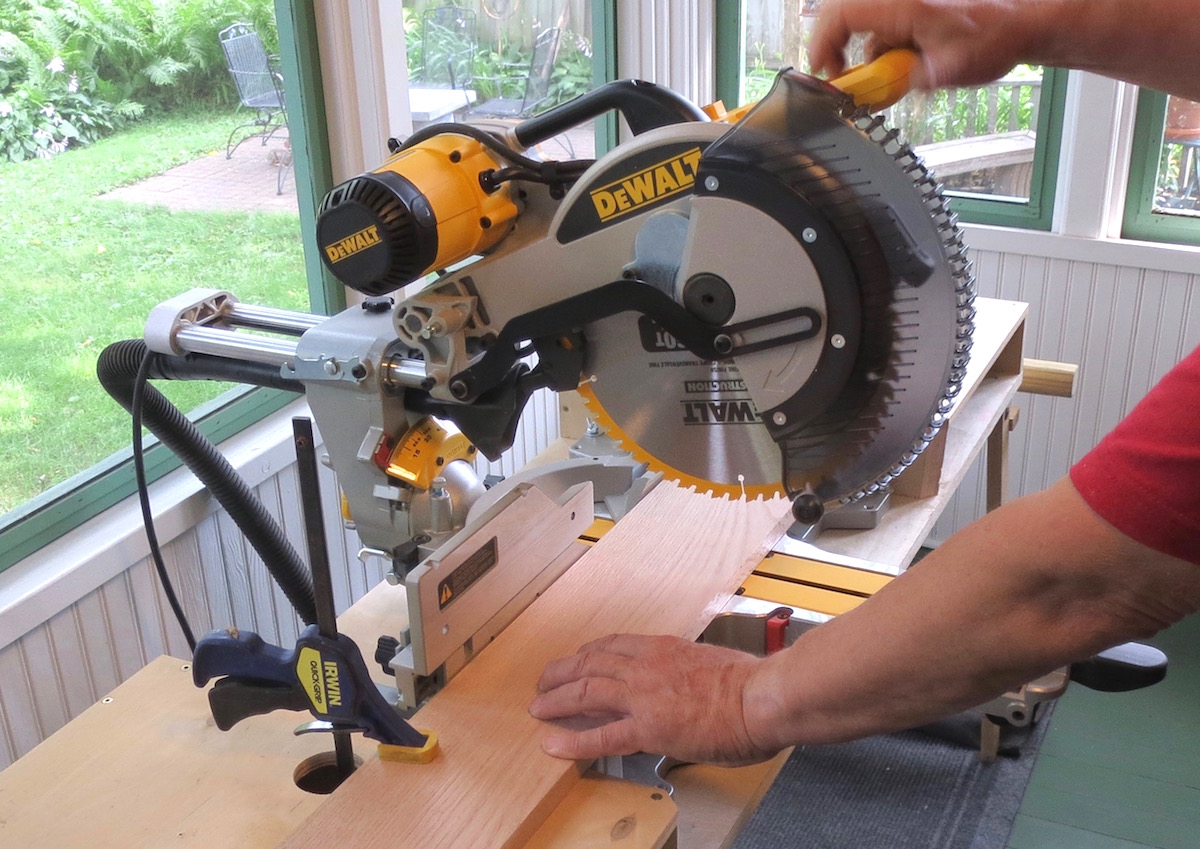 If you’re considering adding a new miter saw to your shop, don’t make a move until you’ve read this great product review of the DeWalt DWS780. Does it make the cut? Read on to find out.
If you’re considering adding a new miter saw to your shop, don’t make a move until you’ve read this great product review of the DeWalt DWS780. Does it make the cut? Read on to find out.
I’ve owned several miter saws in my woodworking career. In fact, when I started out in carpentry, we were still using hand-powered miter saws to cut door and window casings. Great strides in safety and function have been made since my first Rockwell power miter saw in the 1970’s (a really scary machine) through the various design changes of the stationary and slide miter saws. Needless to say, as I opened the box of my new Dewalt DWS780 sliding dual bevel miter saw I was eager to see the latest improvements!
This saw is impressive from the start. The retail cost is around $600 so your pocketbook tells you right away that it’s definitely a saw designed for the professional. But keep an eye out for sale prices more in the $400 range. Since I carry my saw with me to installation jobs, I was hoping it would be a bit lighter than its 56 lbs., but I soon realized that a saw with this much stability and function couldn’t be a featherweight. This saw was ready to go and cut accurately right out of the box. That being said, I encourage you to check yours with test cuts before plunging into a project. The machine is fully adjustable, and after set-up will give very precise results from a simple crosscut to a complex compound crown-molding cut.
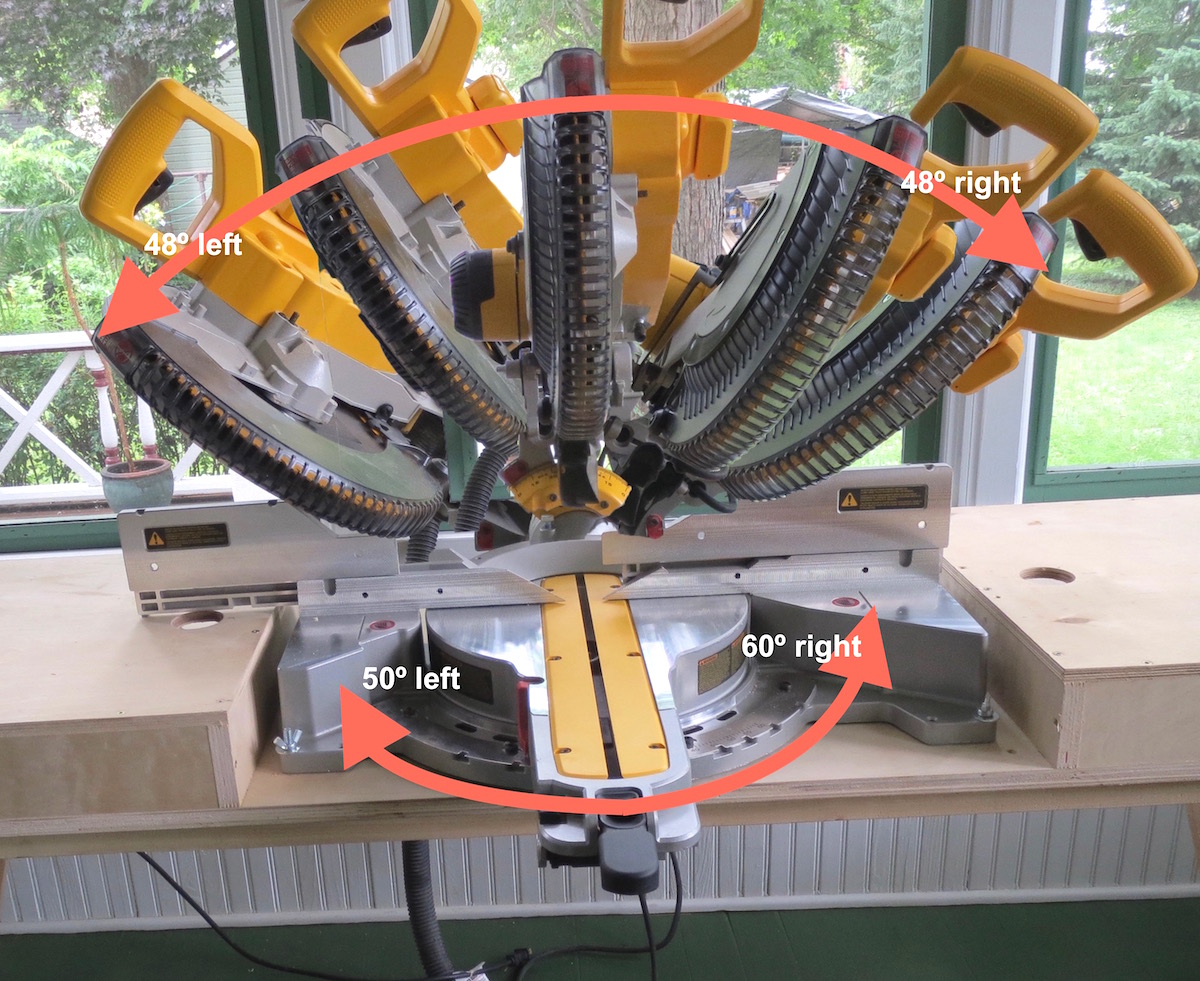 This saw is extremely versatile. You can cut a full 48-degree bevel to the right or left. Miters are equally versatile allowing you to cut 50-degrees to the left and a full 60-degrees to the right. The dual bevel feature allows you to cut your workpiece in the orientation you choose which will help minimize errors caused by flipping workpieces upside down or end-for-end (your only choice with single-bevel saws).
This saw is extremely versatile. You can cut a full 48-degree bevel to the right or left. Miters are equally versatile allowing you to cut 50-degrees to the left and a full 60-degrees to the right. The dual bevel feature allows you to cut your workpiece in the orientation you choose which will help minimize errors caused by flipping workpieces upside down or end-for-end (your only choice with single-bevel saws).
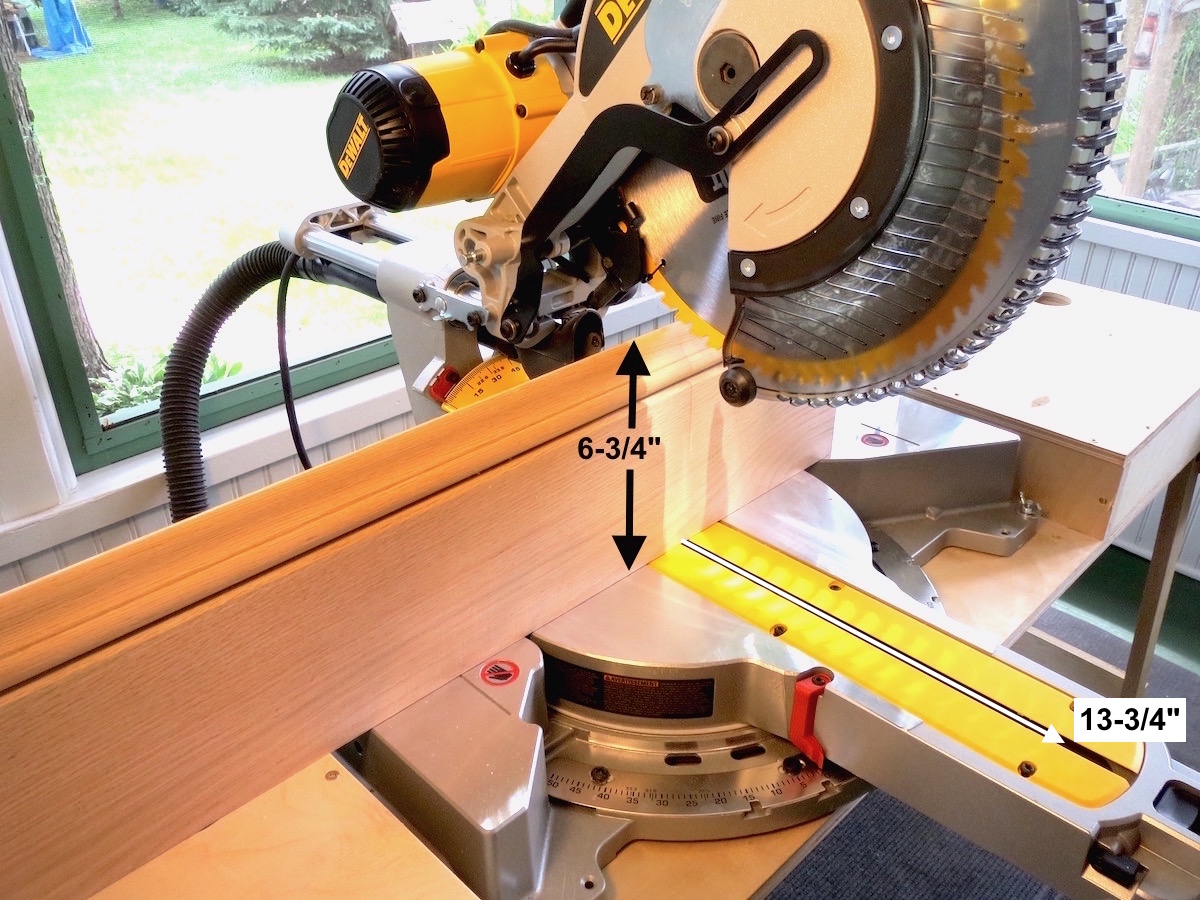 The saw is designed to satisfy large capacity needs. It can make straight horizontal cuts up to 13-3/4” which means you could crosscut a 2 x14 laid flat on the table. For cabinet makers, this means cutting shelving without having to flip the pieces over to finish the cuts. It also can cut baseboard pieces up to 6-3/4” high because the motor is stacked above the saw and driven with a belt, providing maximum depth of cut.
The saw is designed to satisfy large capacity needs. It can make straight horizontal cuts up to 13-3/4” which means you could crosscut a 2 x14 laid flat on the table. For cabinet makers, this means cutting shelving without having to flip the pieces over to finish the cuts. It also can cut baseboard pieces up to 6-3/4” high because the motor is stacked above the saw and driven with a belt, providing maximum depth of cut.
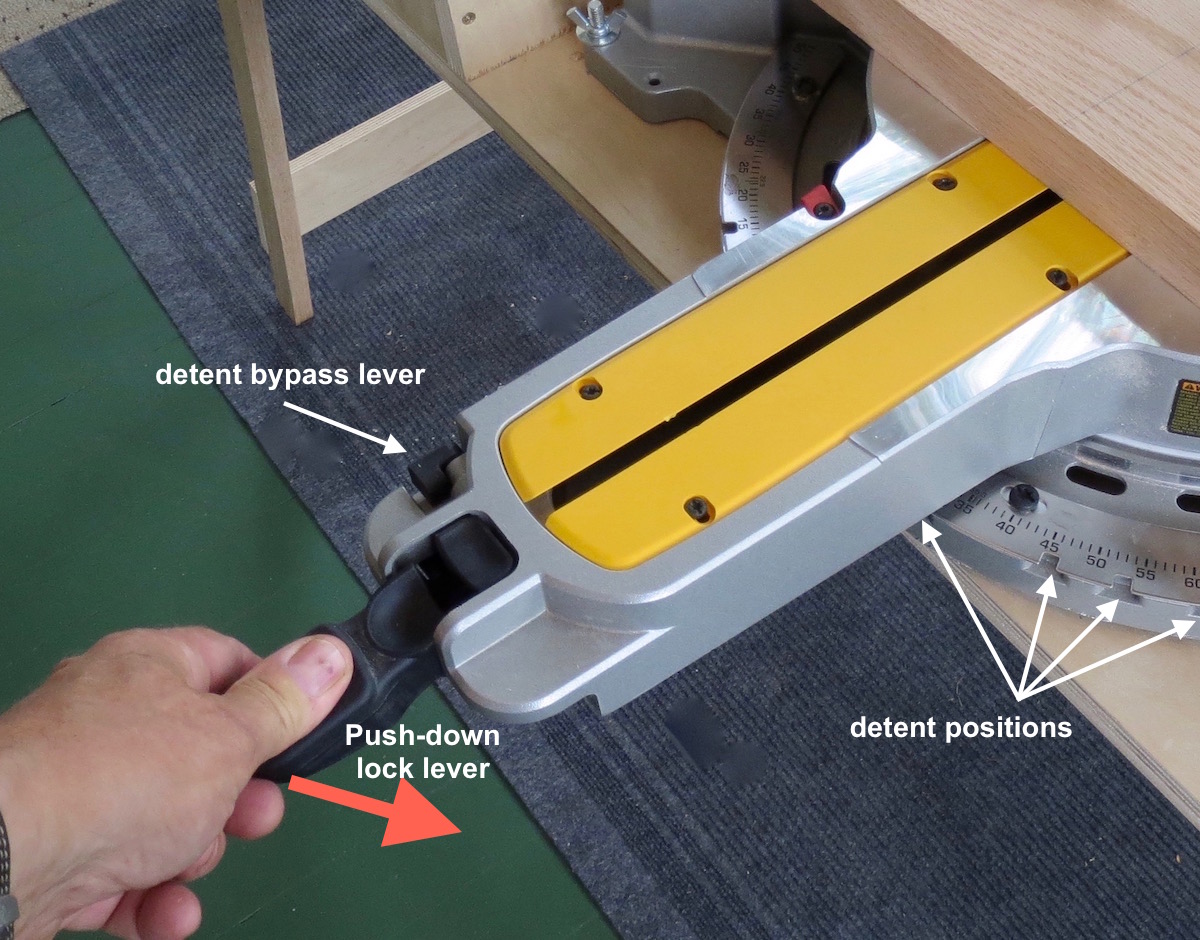 The saw table rotates nicely and is hassle-free. The lock lever needs just a downward push to lock the blade to any angle of miter cut. No more twisting and turning knobs. The table also stops at convenient detents for common cuts and for cutting crown molding flat against the table. If you need infinite variability, a bypass lever gets you free of detents and allows you to quickly move to any degree.
The saw table rotates nicely and is hassle-free. The lock lever needs just a downward push to lock the blade to any angle of miter cut. No more twisting and turning knobs. The table also stops at convenient detents for common cuts and for cutting crown molding flat against the table. If you need infinite variability, a bypass lever gets you free of detents and allows you to quickly move to any degree.
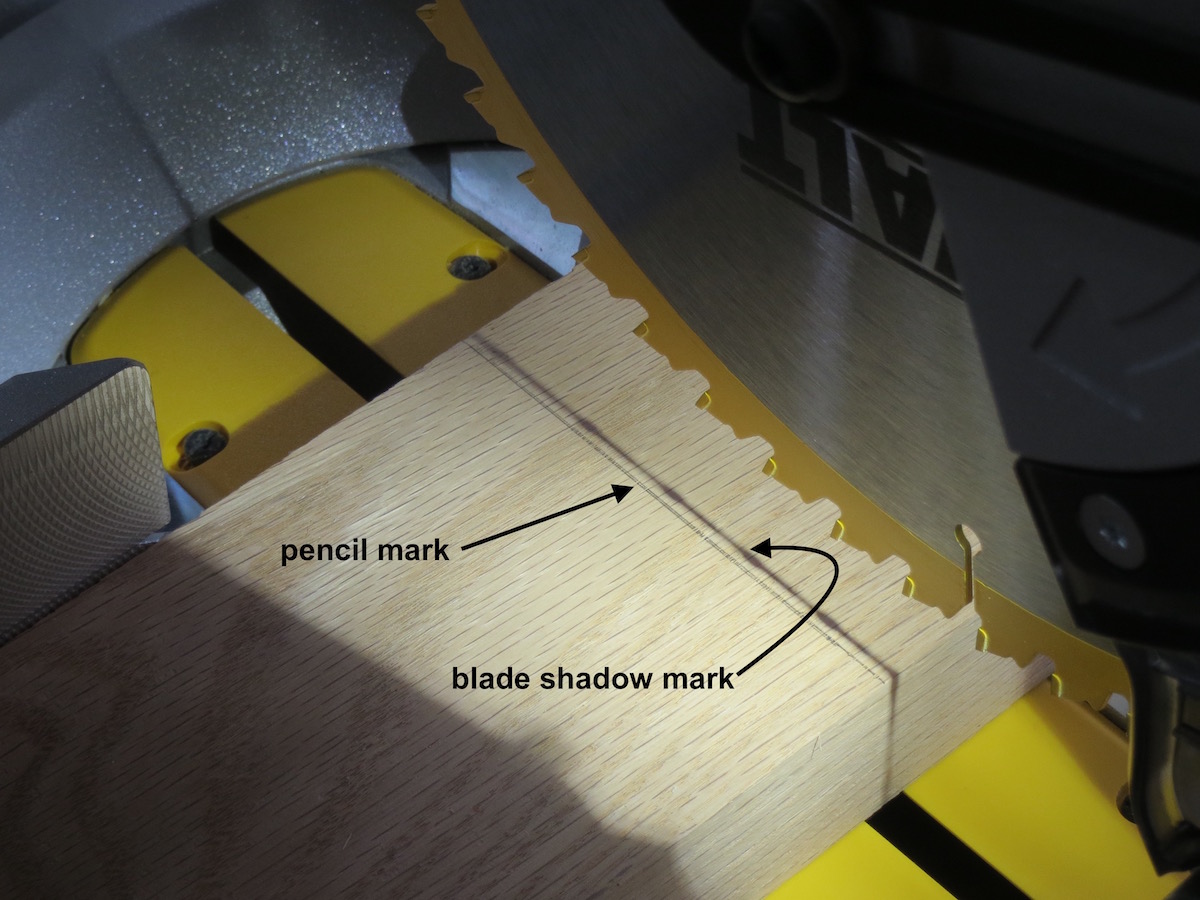 The blade shadow feature is really helpful. I’ve used laser guides before, but this is so accurate that even the teeth of the saw blade can be seen from the shadow cast from the bright LED lights that straddle the blade. Just align your pencil line with the saw blade shadow for an extremely accurate cut line. This feature is great indoors, but won’t perform as well outdoors on a sunny day.
The blade shadow feature is really helpful. I’ve used laser guides before, but this is so accurate that even the teeth of the saw blade can be seen from the shadow cast from the bright LED lights that straddle the blade. Just align your pencil line with the saw blade shadow for an extremely accurate cut line. This feature is great indoors, but won’t perform as well outdoors on a sunny day.
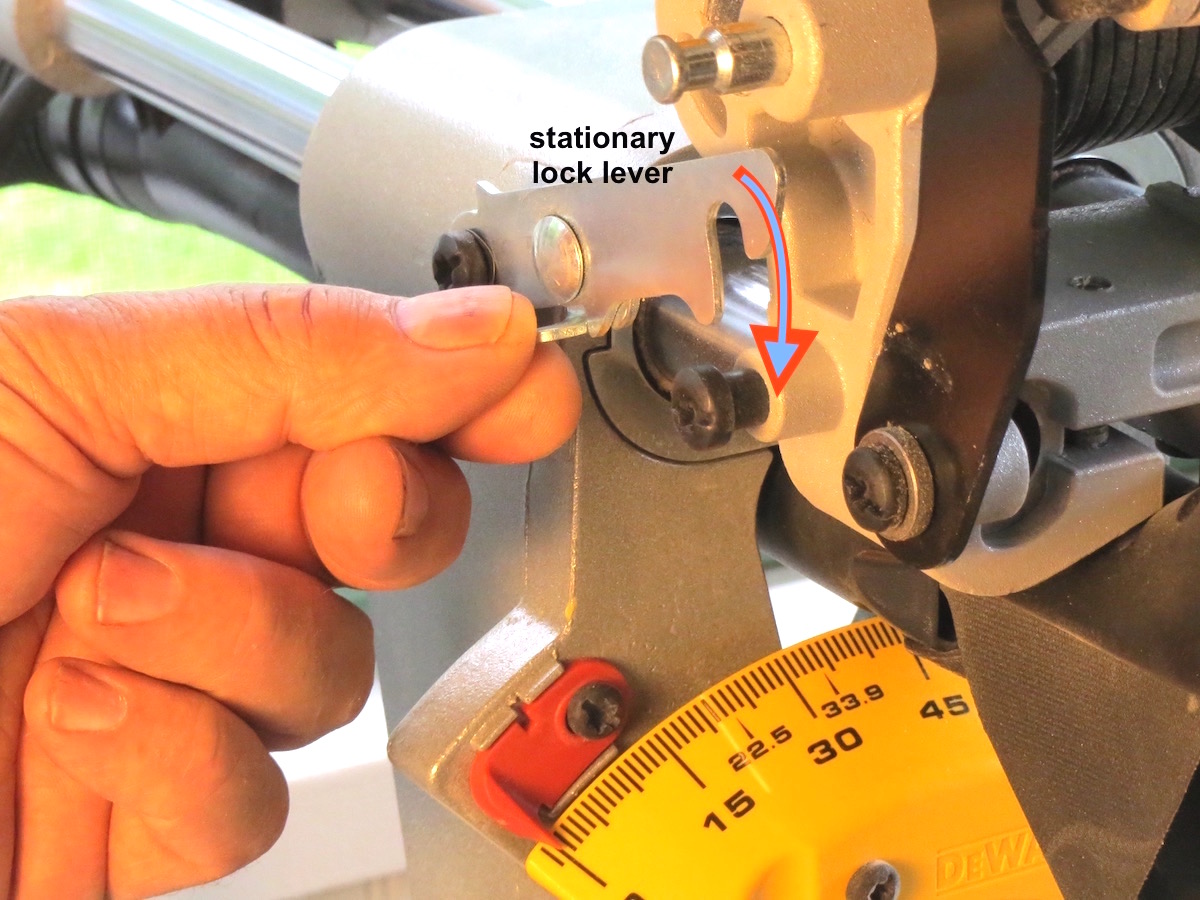 The stationary lever is a nice feature when you don’t need to cut with the slide mechanism. The lever flips onto a stud and prevents the saw from sliding so you can cut smaller trim in the old-fashioned “chop” mode. For best results, turn the lock knob on top of the glide tube to ensure it stays locked even if the lever gets bumped.
The stationary lever is a nice feature when you don’t need to cut with the slide mechanism. The lever flips onto a stud and prevents the saw from sliding so you can cut smaller trim in the old-fashioned “chop” mode. For best results, turn the lock knob on top of the glide tube to ensure it stays locked even if the lever gets bumped.
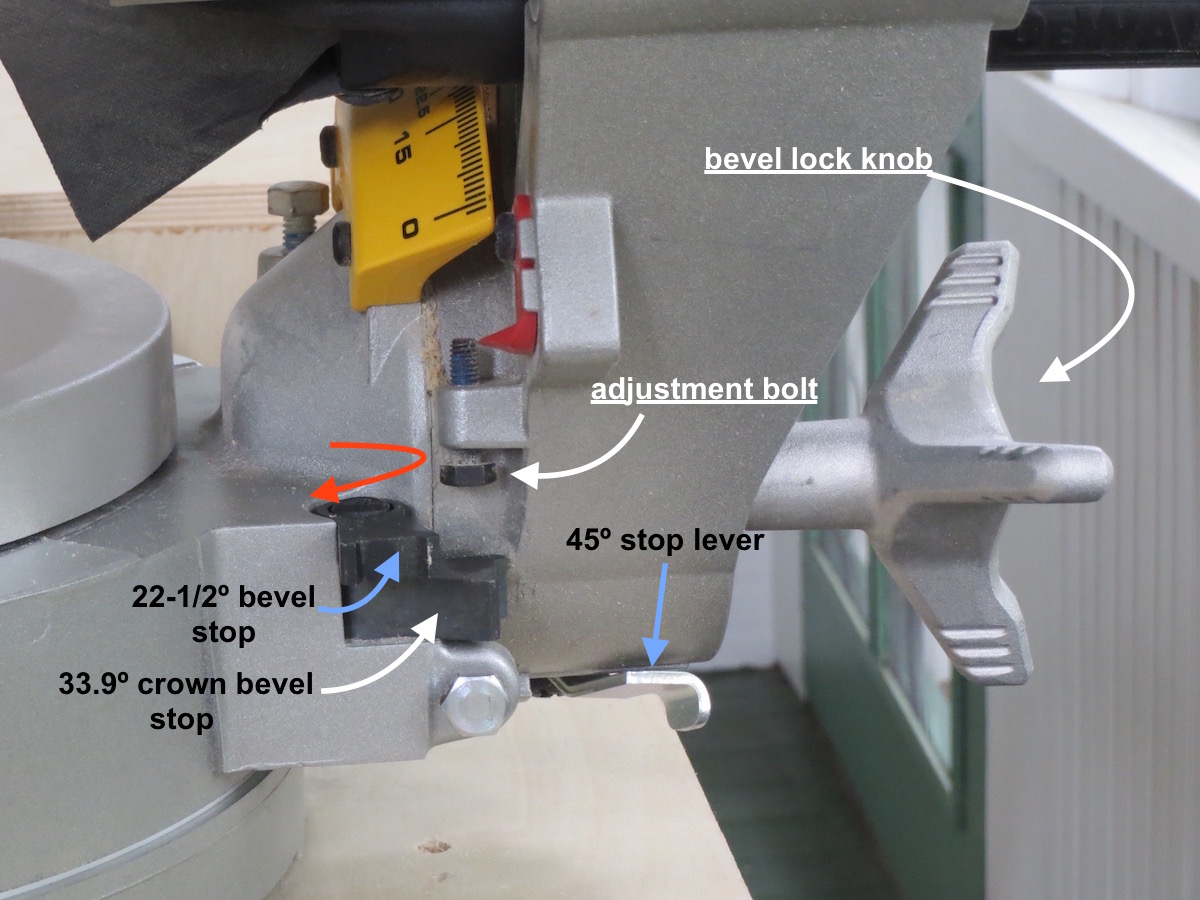 The saw has bevel adjustments galore! There are stop pawls for 22-1/2 degrees and 33.9 degrees that can be rotated into or out of position easily. You’ll also find a 45-degree stop lever that you can turn out of the way if you need a bevel cut at 48+ degrees. The bevels are easily adjusted and will remain accurate as long as you are careful with your saw during transport.
The saw has bevel adjustments galore! There are stop pawls for 22-1/2 degrees and 33.9 degrees that can be rotated into or out of position easily. You’ll also find a 45-degree stop lever that you can turn out of the way if you need a bevel cut at 48+ degrees. The bevels are easily adjusted and will remain accurate as long as you are careful with your saw during transport.
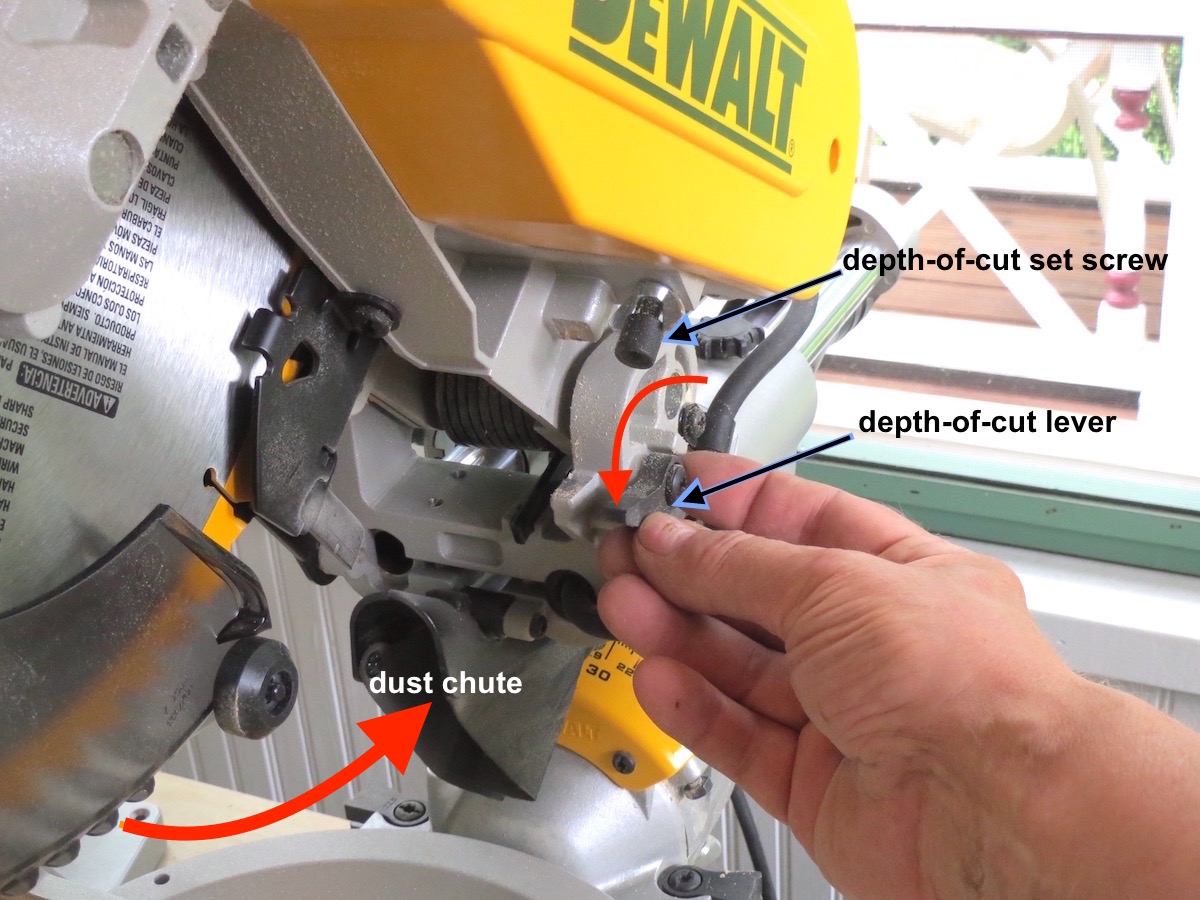 Another cool feature is the depth of cut lever. This lever can be pulled down so you can keep the blade from cutting through your workpiece. You can adjust the depth precisely by moving the depth-of-cut set screw in or out. This nifty adjustment will allow you to cut a dado across a board. To do this however, you’ll need to position a spacer between the workpiece and the fence to ensure the dado cut will extend all the way to the back of the board.
Another cool feature is the depth of cut lever. This lever can be pulled down so you can keep the blade from cutting through your workpiece. You can adjust the depth precisely by moving the depth-of-cut set screw in or out. This nifty adjustment will allow you to cut a dado across a board. To do this however, you’ll need to position a spacer between the workpiece and the fence to ensure the dado cut will extend all the way to the back of the board.
The dust chute is strategically placed to collect the majority of sawdust. I used a vacuum attached to the vac port on the back of the saw, which was an improvement over the bag provided.
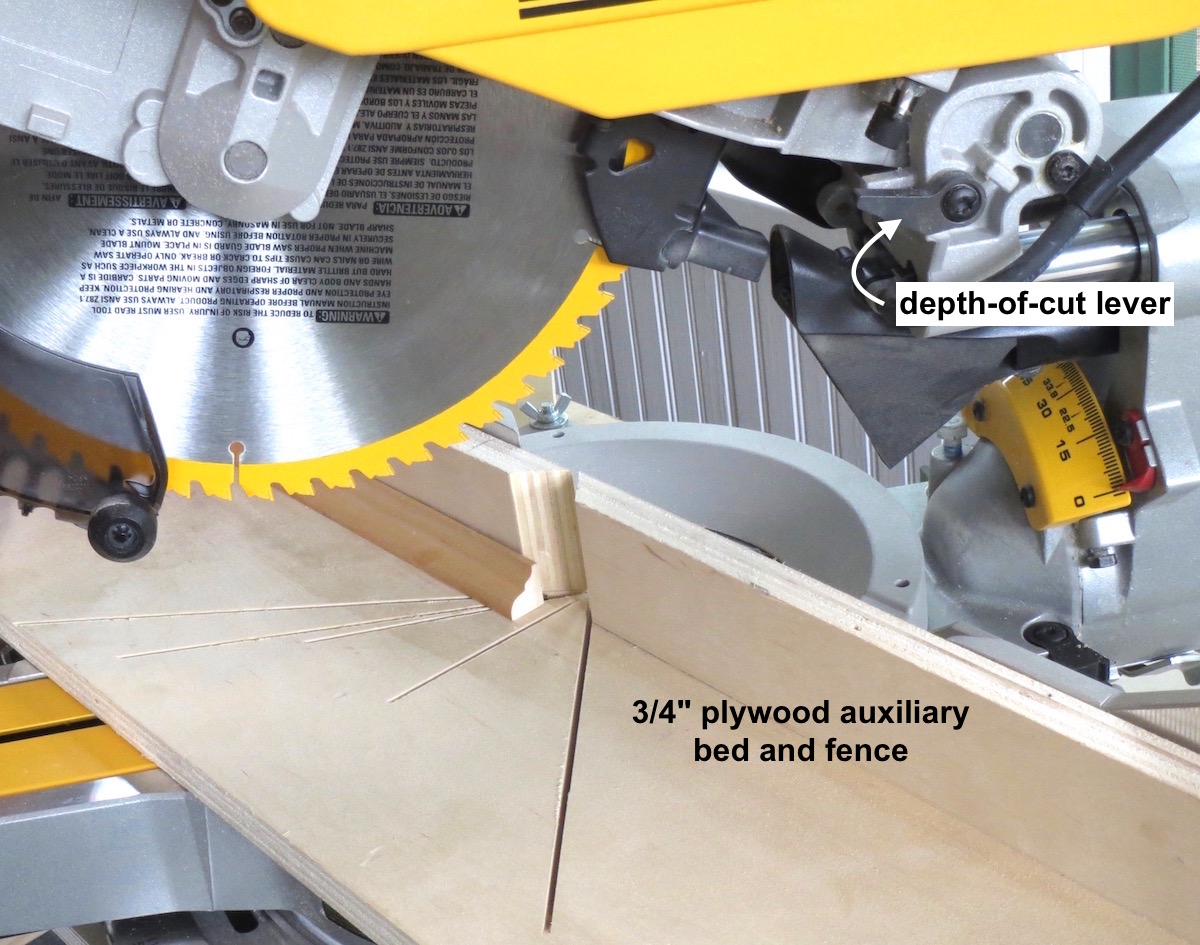 The depth-of-cut feature works well for an auxiliary bed and fence. I often cut small moldings with my miter saw but find that the factory fence doesn’t give enough support for tiny pieces. That’s when I mount my auxiliary fence to the saw. My bed and fence are permanently glued together. The depth-of-cut adjustment keeps the blade from cutting all the way through the plywood bed so I can focus on the cut and not worry about ruining the fixture.
The depth-of-cut feature works well for an auxiliary bed and fence. I often cut small moldings with my miter saw but find that the factory fence doesn’t give enough support for tiny pieces. That’s when I mount my auxiliary fence to the saw. My bed and fence are permanently glued together. The depth-of-cut adjustment keeps the blade from cutting all the way through the plywood bed so I can focus on the cut and not worry about ruining the fixture.
In summary, if you’re looking for an accurate, durable and smooth cutting saw with ample power for thick wood, this is a saw worth considering. You could spend more but in my opinion this saw is capable of the finest cuts you’ll need to make especially if you upgrade from the 60-tooth to an 80-tooth or higher count blade. The saw doesn’t come with extension supports but a good work support stand is available from Dewalt, or you could do like most woodworkers and build your own saw stand to suit your needs.

Heya i am for the first time here. I came across this board and I in finding It really helpful & it helped me out much. I'm hoping to provide something back and help others such as you aided me.
Great review! Educational for a novice like myself. I'm new to woodworking, and an illness has taken my left arm/leg. So many tools/tasks, such as using a table saw, are not a (safe) option for me. So my question to anyone who has this saw... Do you think using this particular saw (and a mountain of different clamps) could be used with one hand? Are there any of the features on it that would require use of 2 hands? ***- I'm aware that this isn't a "novice" tool, but I've made a few mistakes in buying things so far, and do not want to make the same mistake of not buying "the best" in terms of value and durability.
Can you use a daddy blade with this saw to cut 3/4” x 3/8” cuts ? Thank you John
purchase the Hitachi 12 inch rigid they were both junk in my opinion hands down the DeWalt is a hundred times better thousand times better
Does anyone know when DeWalt will offer the DWS780 TYPE20 (Made in Taiwan) with the free stand? The current sale at AMAZON, HomeDepot etc. only involves the TYPE1 (Made in Mexico) . Type 1 has a very sticky slide because of a bronze bushing while TYPE 20 uses ball bearings on both slides.
Does anyone know when DeWalt will offer a special of a free stand when you purchase a DWS780 Type 20 which is made in Taiwan and has ball bearing slide on the right? Amazon, HomeDepot and several other vendors are running a sale now but they are only offering the Type 1 saw which has a very sticky right rail, supported by a bronze bushing. I mistakenly purchased one of those and am returning it. Type 1 and type 20 saws are visually indistinguishable; the only way to identify one from the other is to look at the label on the motor.
Great article, I'm sold, I'll purchase one for our retirement community wood shop here at Highland Farms in western North Carolina.
"I used a vacuum attached to the vac port on the back of the saw, which was an improvement over the bag provided." I bought this saw in December and it's been a great addition to my shop. However, when I'm using it in slide mode, neither my dust collector nor shop hose stay attached. I can't find an adapter to fit exact so I can clamp the hose on. What do you suggest?
I love mine it is real work saver it can do anything a radial arm saw can do and more and does it flawless just a great work horse
When did they add the depth of cut. My saw must be older (2008). Can it be retro fitted? - Bud